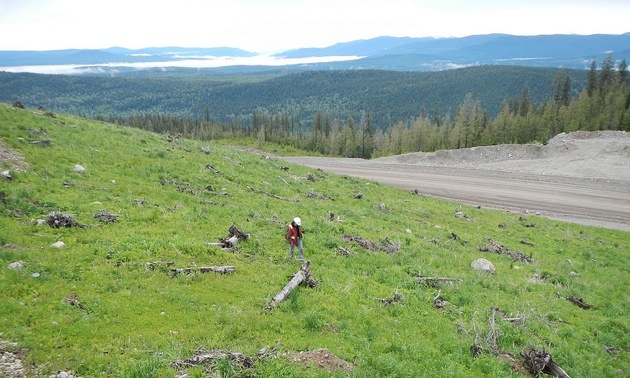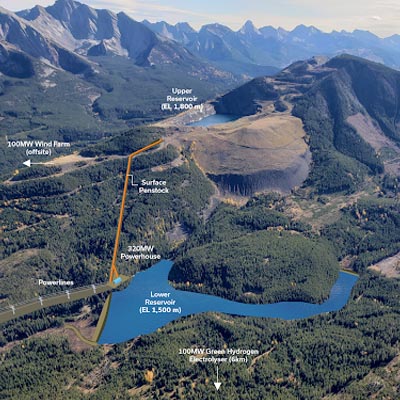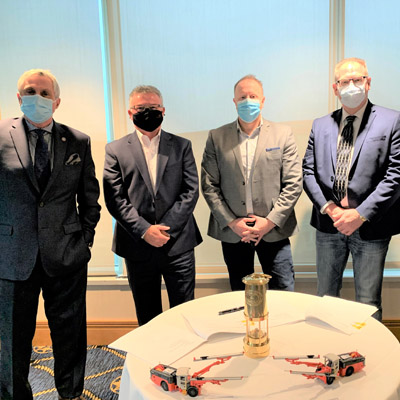Reclamation must be site-specific
"Prescriptions need to be tailored to the specific mine site"

Jennifer McConnachie, an inspector of mines and reclamation for the province of British Columbia, inspects a waste rock dump that has undergone progressive reclamation at a mine site in the B.C. interior. — Photo courtesy of the BC Ministry of Energy and Mines
An inspector of mines and reclamation for the province of British Columbia said adopting a single reclamation model for B.C.’s mines won’t work.
Jennifer McConnachie said after a recent presentation concerning high-level mine reclamation that B.C. is too diverse an area for such a practice to be effective. McConnachie, who is based in Prince George and has been in her position with B.C.’s Ministry of Energy and Mines for one year, is an inspector with jurisdiction throughout the province.
“The whole premise of the presentation was that reclamation plans and prescriptions need to be tailored to the specific mine site,” McConnachie said.
“A big part of my presentation spoke to the fact that reclamation is site-specific. So there’s not a ‘one-size-fits-all’ recipe. And I pointed towards northern B.C. as an illustration of the fact that each mine or exploration site is located in a very diverse area, where reclamation planning must be fine-tuned for that specific area. You can’t just umbrella the entire province with one recipe.”
A mining history
It’s probably no surprise that McConnachie has chosen mine inspection and reclamation as a career. She’s originally from Kimberley, B.C., home of the 92-year-old Sullivan Mine, which during its lifetime produced lead, zinc, silver and tin until it closed in 2001. Teck Resources Limited has been involved in an extensive decommissioning and reclamation process at the site since then.
“So I saw mine operations every day,” McConnachie said. “And I watched that site when they were doing that reclamation, that the company implemented. It was eye-opening how much effort it takes to reclaim such an extensive disturbance.”
McConnachie’s current job focuses on major mines, although she also reviews plans for small mines and exploration projects. She reviews proposed and existing reclamation programs for both open and closed major mines, makes recommendations to enhance those plans, and conducts mine inspections to review and evaluate reclamation programs. Her specialties are site soils and vegetation and land-use objective capabilities.
McConnachie decided to concentrate her recent presentation on explaining just precisely what a mine reclamation is and also briefly described the permitting process. The government considers reclamation important at least partly because provincial legislation regards mining as a temporary land use.
Although reclamation involves things like decommissioning buildings and removing hazardous materials, McConnachie concentrated on the green side of reclamation. She talked about salvaging soil before the development of a mine site and its reuse during the reclamation process. She also talked about the importance of using native plant species during mine reclamations and that their available supply is often overlooked in some reclamation plans.
Reclamation integral to mine planning
As for the permitting process, that’s initiated once a mine company submits an application to construct a mine. BC Mines Act permits now actually include mines plan and reclamation program permits. In other words, a potential new mine is not approved by the province unless an acceptable reclamation program is included with the mine permit application.
The application is reviewed by relevant agencies, which can include not only McConnachie’s ministry but also the Ministry of Forests, Lands and Natural Resource Operations and the Ministry of the Environment, and then potentially affected First Nations and the public. Once all information is collected, it’s reviewed. If more information is required, the mine company will again be contacted.
“If we’re going to approve (a project), then the next step would be, one, write up permit conditions and, two, request a security—a monetary bond that is put in place to reduce the possibility that public funds might be required to reclaim a mine,” McConnachie said.
Once operations begin, a company must provide evidence that the permit conditions it has agreed to are being met. That requires monitoring and documentation.
The province holds the bond initially submitted by the company until all reclamation objectives have been met. If a company fails to meet these objectives, then the province can use the bond to pay for site reclamation.
McConnachie said the biggest challenge in her job at present is the sheer volume of work. Not only is north central B.C. currently undergoing a bit of a mining boom, but also some major proposed projects have lengthy applications.
But McConnachie does believe that along with growing mining activity, companies are increasingly realizing the importance of the environment.
“There’s more awareness that reclamation planning must be quite integral to mine planning,” she said. “Gone are the days where you can open a mine site and wait until the very end before you start considering mine reclamation.”




